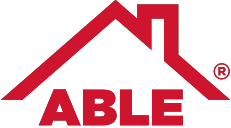Spring cleaning should apply to the outside of your home as much as the inside. If you’re planning on sprucing up your living space this spring, be sure to take time to inspect your home’s exterior, particularly the roof. Winter weather can take a toll on your home’s roof, and spring can bring heavy rains and high winds in some areas that can make small problems worse. Keeping track of your roof’s health can help you identify small problems before they grow into much bigger, more expensive issues.
Chimney damage
Whether you used your fireplaces over the winter or not, it’s worth taking time to inspect your chimney in the early spring. Look for signs that your chimney needs repair. A dormant chimney is a prime location for animals to nest to stay out of the winter cold, and you do not want your chimney to become a breeding ground for birds, rodents, or insects.
It’s also a good idea to keep your chimney in good shape to prevent leaks and preserve the property value of your home. Even if you don’t like using your chimney, if you ever decide to move, a functional chimney could attract buyers and help you maintain a higher asking price. If you plan on staying in your home for many years to come, a functional chimney could be more of an asset than you realize, and you may want to eventually use it during the colder weather. Spring is a great time to schedule a chimney inspection, and it can save you a tremendous amount of money in the long run if you stay on top of it.
Cracked or missing shingles
The shingles on your roof are the first line of defense for your home against the rain and snow. As the snow melts and the spring weather takes hold in your area, inspecting your shingles should be at the top of your home maintenance priority list. Assess wind damage, and take time to look around your yard for shingle fragments. You’ll usually find them a foot or two away from the edge of your roof’s eaves in your yard. You should also check your downspouts for shingle granules. If they are settled in the bottom of your gutters, that is normal, but if you notice them beneath your downspouts, this is a strong indication your shingles need attention.
If you can check your roof easily from the ground, look for any spots that appear cracked, warped, or discolored. You should also pay close attention to any spots where the shingles are completely missing. If you can see any of the roof bed between your shingles, it’s time to call a reliable professional roofer for some work. Springtime is a good time to have your shingles replaced. Worn shingles do not withstand spring rains like new shingles.
Leaks allowing water into the attic
Take time to check your attic or crawlspace this spring. Look around carefully during the daylight hours for any spots where you can see light entering the interior space. If you notice any sunlight streaking inside, you should call your roofer right away; these places are likely allowing moisture to enter your home, and this water damage will escalate very quickly. Water damage is not only expensive to repair, but also poses a health hazard by allowing mold to grow and attracting pests.
Identifying leaks as soon as possible is one of the best ways to keep your home safe and functional this spring. If you’re going to be doing spring cleaning and reorganizing as the nice weather rolls in, make sure your roof isn’t going to let the rain leak all over the items you store in the attic.
Gutters in disrepair
Gutters protect your home in many ways. They transfer rain off of your roof and funnel it away from your home. Make sure you inspect your gutters carefully at the start of the spring and look for any places that look loose, cracked, or rusted. These issues will worsen with repeated spring rains, so taking care of them as soon as possible will save you more expensive repair bills later.
As you inspect your gutters, make sure you look inside them and clear out any accumulated debris like shingle fragments, leaves, twigs, and other debris. This is a good time to do a checkup on your roof’s shingles, too. If you notice lots of debris in your gutters, you might want to consider asking your roofer about installing gutter shields. These devices prevent your gutters from filling up with debris while allowing rain to pass through them easily.
Physical damage to the roof
Your roof is still vulnerable even if it’s newly replaced. Roofs can sustain physical damage from many different sources, including high winds, hailstones, and invasive animals like birds, squirrels, and raccoons. Periodically, and especially after a storm, take a look around your roof and pay close attention to the areas around vents, the ridges of the roof, and the flashings around your roof vents. If you notice any physical damage, don’t wait too long to call your roofer and have it corrected.
If you seem to notice a pattern of physical damage to your roof, whether it’s shingles constantly winding up in your yard, invasive animals, or damage from the weather, talk to your roofer about potential solutions. Depending on the age of your roof, it may be time for a replacement or an upgrade to a different type of roof.
Roof issues are never fun for homeowners to address, and a little preventive care and maintenance can go a long way when it comes to saving money on repairs. As we move into the spring months, do your best to inspect your roof for these and other issues. If you encounter any problem you can’t fix yourself, contact Able Roof for a free estimate on the work you need done, and we will let you know how we can help.








